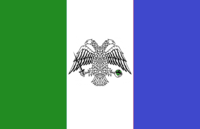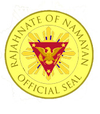Rajahnate of Namayan
This article refers to a micronation or element of micronationalism which is defunct and no longer exists. You can help make the article reflect that or ask on the talk page for further information. |
Rajahnate of Namayan Rahanato ng Namayan Kerajaan Namayan | |
|---|---|
| Motto: Adapting with Nature | |
| Capital | Lequia Prefecture |
| Official languages | English, Tagalog, Cebuano |
| Demonym(s) | Namayan |
| Government | Constitutional Elective Monarchy Military junta (11 July 2016 - 15 September 2016) |
• Rajah (King) | Darvinos I |
• Prime Minister | vacant |
• Chairman of the Junta | Migs Caldeo |
| Legislature | Royal Assembly of Senators |
| Establishment | 12 June 2013 |
| Population | |
• Census | 6 citizens, 37 residents (as of 17 June 2016) |
| Currency | Philippine solidus (pegged at Philippine peso) |
The Rajahnate of Namayan (Filipino: Rahanato (Kaharian) ng Namayan) is a political simulation organization commonly referred to as a micronation by external observers, which mainly operates in the Philippines. Founded in 2013, it is presently governed as an elective monarchy, with various political parties legalized in its numerous prefectures. Its capital city is the Lequia City, an area of influence coinciding with some parts of the City of Manila and Quezon City in the Philippines. The current constitution was enacted on 1 October 2014 and was amended on 25 January 2015. The last head of state is Rajah Darvinos I, who assumed the throne on 18 June 2016.[1]
On 11 July 2016, the Provisional Committee for National Affairs seized control of Namayan and effectively placed the micronation under their junta while retaining the position (albeit greatly reducing the powers) of Rajah Darvinos I. On 15 September 2016, Rajah Darvinos I abdicated the throne, which in effect, paved the way for the dissolution of the Rajahnate of Namayan.
Principate Era
On 1 October 2014, the new constitution which effectively transformed Namayan was promulgated. Timothy John Laranang was elected as the new Rajah (King) of Namayan and Eugenio de Namayan became the Prime Minister. The transformation was positively accepted by other Philippine micronations like the Daikoku Federation and the State of Kaleido.
On 1 January 2015, Monjer Camama won the year-end elections and assumed the throne of the Rajahnate, becoming Rajah Monjer I. Timothy Laranang was also elected as the Prime Minister.
Unification with Daikoku
A neighboring micronation, the Republic of Daikoku expressed its desire to unite with Namayan in a federal-type government as early as November 2014. However, external and internal factors prevented Namayan government officials to finalize a decision. Instead of a unification back then, diplomatic ties were established on 24 November 2014 as a precursor to the unification.
On 10 January 2015, the Rajahnate of Namayan was declared a "Sixth World" micronation under the Boodlesmythe-Tallini System and it scored a 3.0 on the Linden's Revised System of Classification.
Unification was executed on 1 February after Namayan Foreign Minister and Plenipotentiary Eugenio de Namayan, and Migs Caldeo, President of the Supreme Council of the Republic of Daikoku, signed a unification treaty at 21:00 (GMT+8) which effectively transformed the Republic of Daikoku into an autonomous republic of the Rajahnate of Namayan.
On 1 April 2015, Monjer Camama was re-elected to the throne of the Rajahnate, retaining his title as Rajah Monjer I. Meanwhile, Eugenio de Namayan was elected as the Prime Minister.
Lequia tensions and secession of Daikoku
On 15 November 2015, Timothy Laranang, disappointed at the decline of the micronation's influence, launched a blockade in San Pedro, Lequia Prefecture, alarming the Prefect Zyper Zillamore of Lequia.[2] Lequia Prefect Zyper Zillamore also resigned due to the tensions on 17 November 2015, appointing Eugenio de Namayan as "acting prefect". Tensions eased on 20 November, following the lifting of the blockade.[3] Timothy Laranang later retired from micronationalism.
Following the distress caused by the blockade, the autonomous Principality of Daikoku seceded from Namayan on 22 November 2015, ending the nine-month union between the two micronations.
Inactivity period
Since June 2015, with the exception of the November 2015 Lequia crisis, activity in the Rajahnate of Namayan went into slow decline, promting Rajah Alfredo I to declare a "hibernation period" on 20 December 2015.[4] No news or significant activities were done from December 2015 to April 2016.

